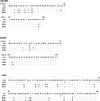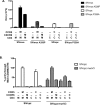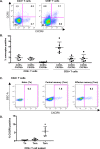Loss of CXCR6 coreceptor usage characterizes pathogenic lentiviruses
- PMID: 29659623
- PMCID: PMC5919676
- DOI: 10.1371/journal.ppat.1007003
Loss of CXCR6 coreceptor usage characterizes pathogenic lentiviruses
Abstract
Pandemic HIV-1 originated from the cross-species transmission of SIVcpz, which infects chimpanzees, while SIVcpz itself emerged following the cross-species transmission and recombination of monkey SIVs, with env contributed by the SIVgsn/mus/mon lineage that infects greater spot-nosed, mustached and mona monkeys. SIVcpz and HIV-1 are pathogenic in their respective hosts, while the phenotype of their SIVgsn/mus/mon ancestors is unknown. However, two well-studied SIV infected natural hosts, sooty mangabeys (SMs) and African green monkeys (AGMs), typically remain healthy despite high viral loads; these species express low levels of the canonical coreceptor CCR5, and recent work shows that CXCR6 is a major coreceptor for SIV in these hosts. It is not known what coreceptors were used by the precursors of SIVcpz, whether coreceptor use changed during emergence of the SIVcpz/HIV-1 lineage, and what T cell subsets express CXCR6 in natural hosts. Using species-matched coreceptors and CD4, we show here that SIVcpz uses only CCR5 for entry and, like HIV-1, cannot use CXCR6. In contrast, SIVmus efficiently uses both CXCR6 and CCR5. Coreceptor selectivity was determined by Env, with CXCR6 use abrogated by Pro326 in the V3 crown, which is absent in monkey SIVs but highly conserved in SIVcpz/HIV-1. To characterize which cells express CXCR6, we generated a novel antibody that recognizes CXCR6 of multiple primate species. Testing lymphocytes from SM, the best-studied natural host, we found that CXCR6 is restricted to CD4+ effector memory cells, and is expressed by a sub-population distinct from those expressing CCR5. Thus, efficient CXCR6 use, previously identified in SM and AGM infection, also characterizes a member of the SIV lineage that gave rise to SIVcpz/HIV-1. Loss of CXCR6 usage by SIVcpz may have altered its cell tropism, shifting virus from CXCR6-expressing cells that may support replication without disrupting immune function or homeostasis, towards CCR5-expressing cells with pathogenic consequences.
Conflict of interest statement
The authors have declared that no competing interests exist.
Figures







Similar articles
-
CCR5 as a Coreceptor for Human Immunodeficiency Virus and Simian Immunodeficiency Viruses: A Prototypic Love-Hate Affair.Front Immunol. 2022 Jan 27;13:835994. doi: 10.3389/fimmu.2022.835994. eCollection 2022. Front Immunol. 2022. PMID: 35154162 Free PMC article. Review.
-
CXCR6-Mediated Simian Immunodeficiency Virus SIVagmSab Entry into Sabaeus African Green Monkey Lymphocytes Implicates Widespread Use of Non-CCR5 Pathways in Natural Host Infections.J Virol. 2017 Jan 31;91(4):e01626-16. doi: 10.1128/JVI.01626-16. Print 2017 Feb 15. J Virol. 2017. PMID: 27903799 Free PMC article.
-
Dualtropic CXCR6/CCR5 Simian Immunodeficiency Virus (SIV) Infection of Sooty Mangabey Primary Lymphocytes: Distinct Coreceptor Use in Natural versus Pathogenic Hosts of SIV.J Virol. 2015 Sep;89(18):9252-61. doi: 10.1128/JVI.01236-15. Epub 2015 Jun 24. J Virol. 2015. PMID: 26109719 Free PMC article.
-
SIV Coreceptor Specificity in Natural and Non-Natural Host Infection: Implications for Cell Targeting and Differential Outcomes from Infection.Curr HIV Res. 2018;16(1):41-51. doi: 10.2174/1570162X15666171124121805. Curr HIV Res. 2018. PMID: 29173179 Review.
-
Down-modulation of primate lentiviral receptors by Nef proteins of simian immunodeficiency virus (SIV) of chimpanzees (SIVcpz) and related SIVs: implication for the evolutionary event at the emergence of SIVcpz.J Gen Virol. 2015 Sep;96(9):2867-2877. doi: 10.1099/vir.0.000207. Epub 2015 Jun 3. J Gen Virol. 2015. PMID: 26041873 Free PMC article.
Cited by
-
CD4 receptor diversity represents an ancient protection mechanism against primate lentiviruses.Proc Natl Acad Sci U S A. 2021 Mar 30;118(13):e2025914118. doi: 10.1073/pnas.2025914118. Proc Natl Acad Sci U S A. 2021. PMID: 33771926 Free PMC article.
-
The impact of genetic adaptation on chimpanzee subspecies differentiation.PLoS Genet. 2019 Nov 25;15(11):e1008485. doi: 10.1371/journal.pgen.1008485. eCollection 2019 Nov. PLoS Genet. 2019. PMID: 31765391 Free PMC article.
-
CCR5 as a Coreceptor for Human Immunodeficiency Virus and Simian Immunodeficiency Viruses: A Prototypic Love-Hate Affair.Front Immunol. 2022 Jan 27;13:835994. doi: 10.3389/fimmu.2022.835994. eCollection 2022. Front Immunol. 2022. PMID: 35154162 Free PMC article. Review.
-
Viral and Cellular Factors Leading to the Loss of CD4 Homeostasis in HIV-1 Viremic Nonprogressors.J Virol. 2022 Jan 12;96(1):e0149921. doi: 10.1128/JVI.01499-21. Epub 2021 Oct 20. J Virol. 2022. PMID: 34668779 Free PMC article.
-
Simian Immunodeficiency Virus Persistence in Cellular and Anatomic Reservoirs in Antiretroviral Therapy-Suppressed Infant Rhesus Macaques.J Virol. 2018 Aug 29;92(18):e00562-18. doi: 10.1128/JVI.00562-18. Print 2018 Sep 15. J Virol. 2018. PMID: 29997216 Free PMC article.
References
-
- Gao F, Bailes E, Robertson DL, Chen Y, Rodenburg CM, Michael SF, et al. Origin of HIV-1 in the chimpanzee Pan troglodytes troglodytes. Nature. 1999;397(6718):436–41. - PubMed
-
- Bailes E, Gao F, Bibollet-Ruche F, Courgnaud V, Peeters M, Marx PA, et al. Hybrid origin of SIV in chimpanzees. Science (New York, NY). 2003;300(5626):1713. - PubMed
-
- Sharp PM, Shaw GM, Hahn BH. Simian immunodeficiency virus infection of chimpanzees. Journal of virology. 2005;79(7):3891–902. doi: 10.1128/JVI.79.7.3891-3902.2005 - DOI - PMC - PubMed
-
- Bell SM, Bedford T. Modern-day SIV viral diversity generated by extensive recombination and cross-species transmission. PLoS pathogens. 2017;13(7):e1006466 doi: 10.1371/journal.ppat.1006466 - DOI - PMC - PubMed
Publication types
MeSH terms
Substances
Grants and funding
- T32 AI007632/AI/NIAID NIH HHS/United States
- P51 OD011132/OD/NIH HHS/United States
- R37 AI050529/AI/NIAID NIH HHS/United States
- R56-AI091516 /NH/NIH HHS/United States
- R37-AI66998 /NH/NIH HHS/United States
- P30-AI045008 /NH/NIH HHS/United States
- R56 AI091516/AI/NIAID NIH HHS/United States
- R01 AI120810/AI/NIAID NIH HHS/United States
- R01-AI120810 /NH/NIH HHS/United States
- R37-AI050529 /NH/NIH HHS/United States
- R01-MH061130 /NH/NIH HHS/United States
- P30 AI045008/AI/NIAID NIH HHS/United States
- R37 AI066998/AI/NIAID NIH HHS/United States
LinkOut - more resources
Full Text Sources
Other Literature Sources
Molecular Biology Databases
Research Materials

